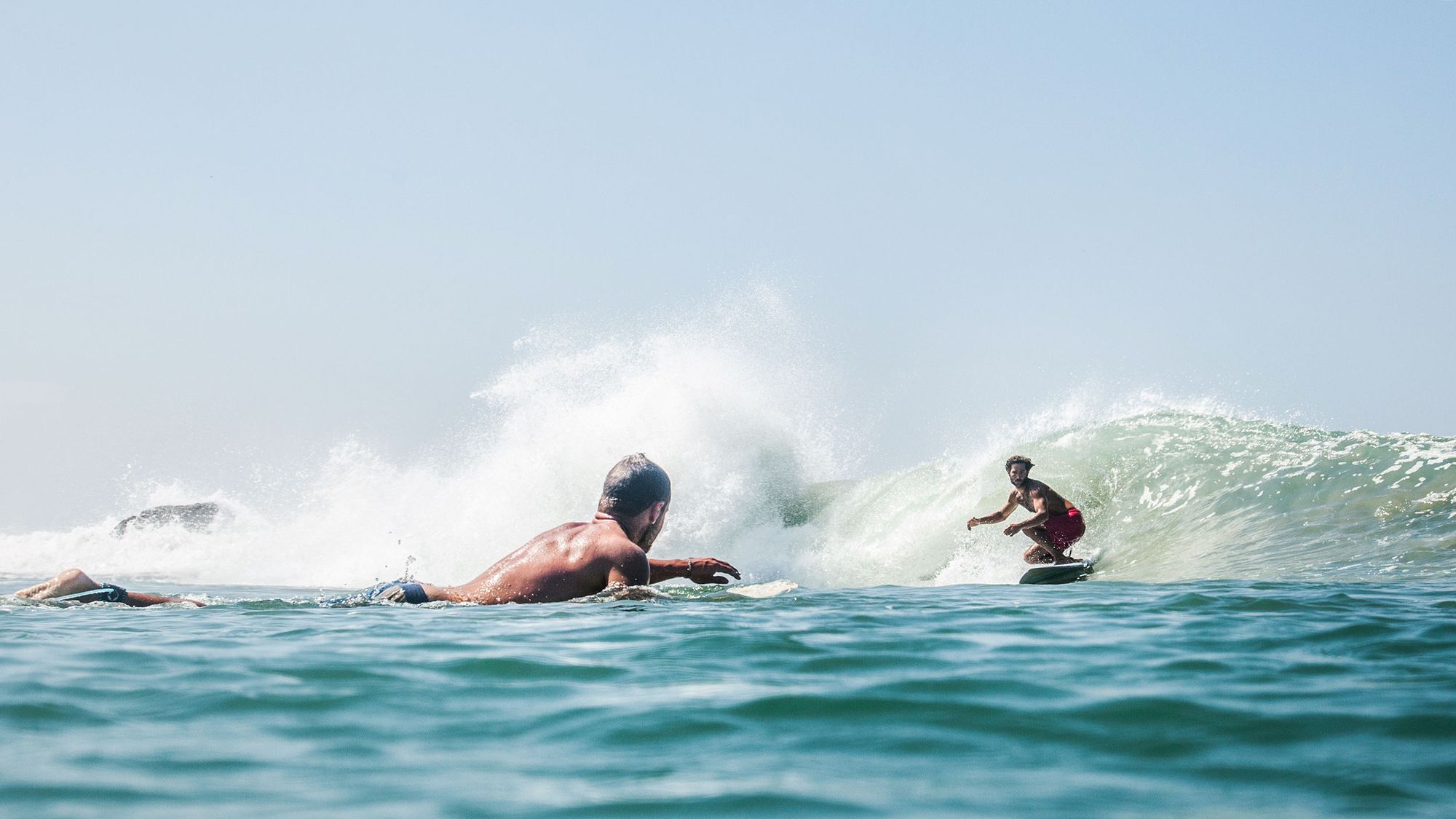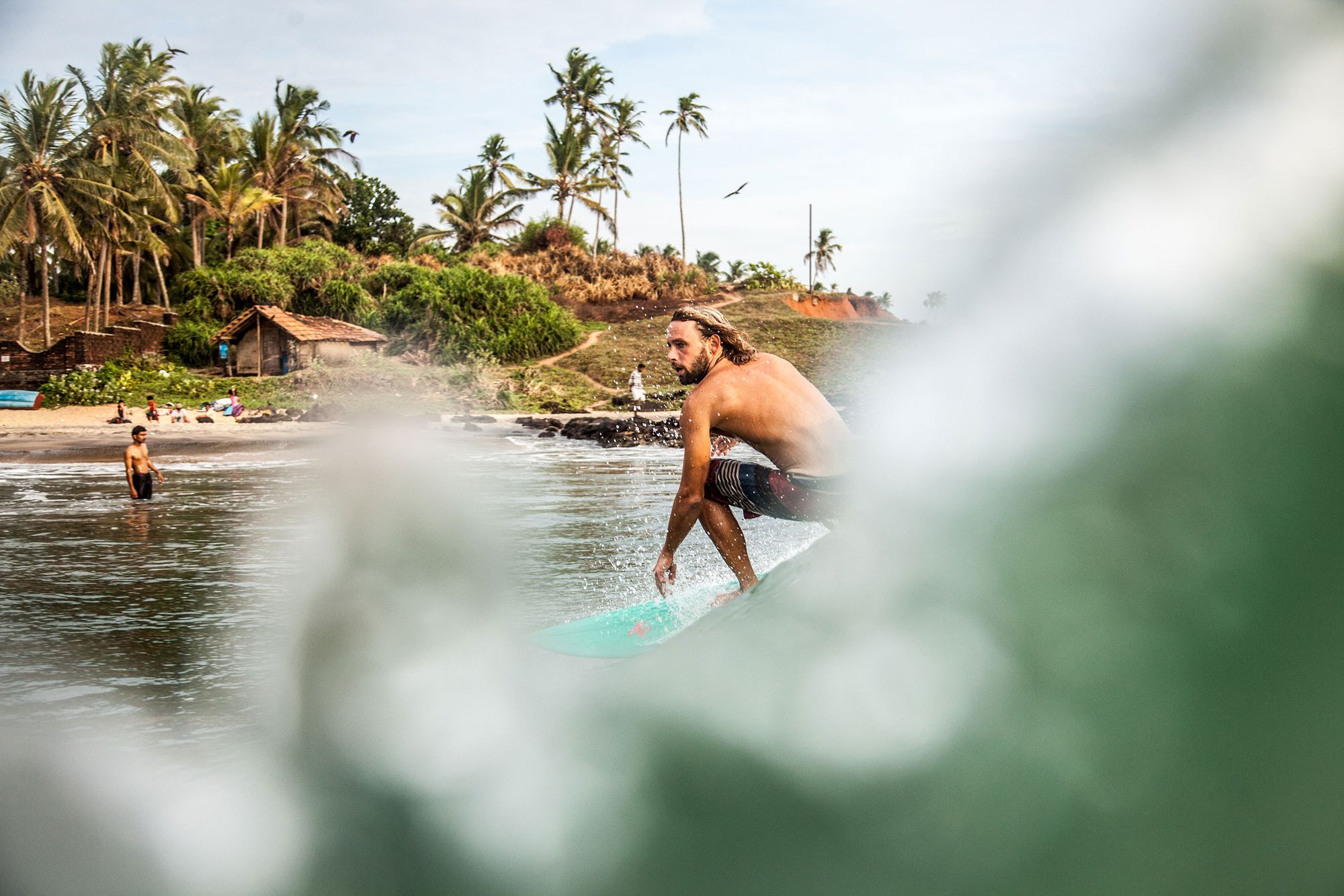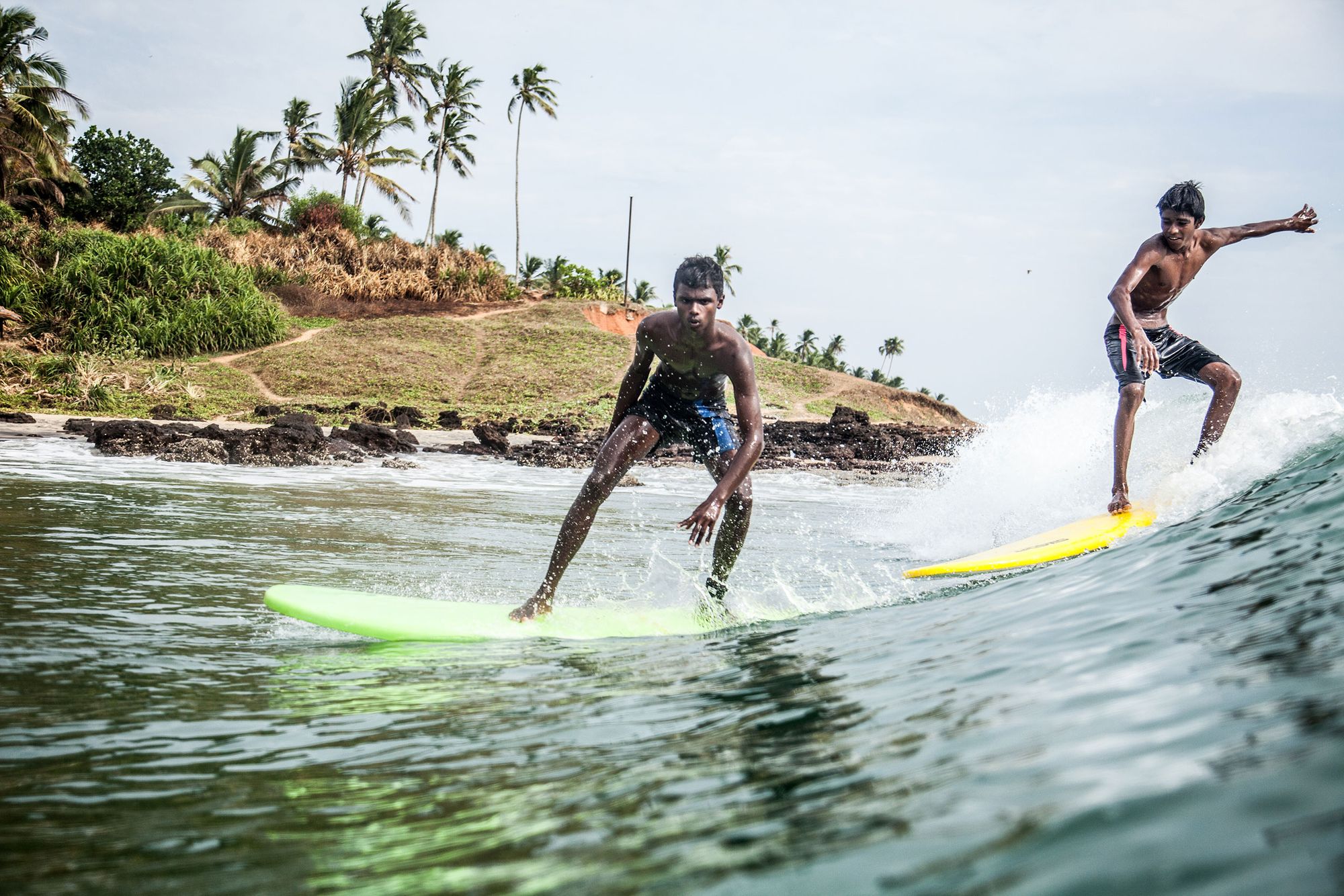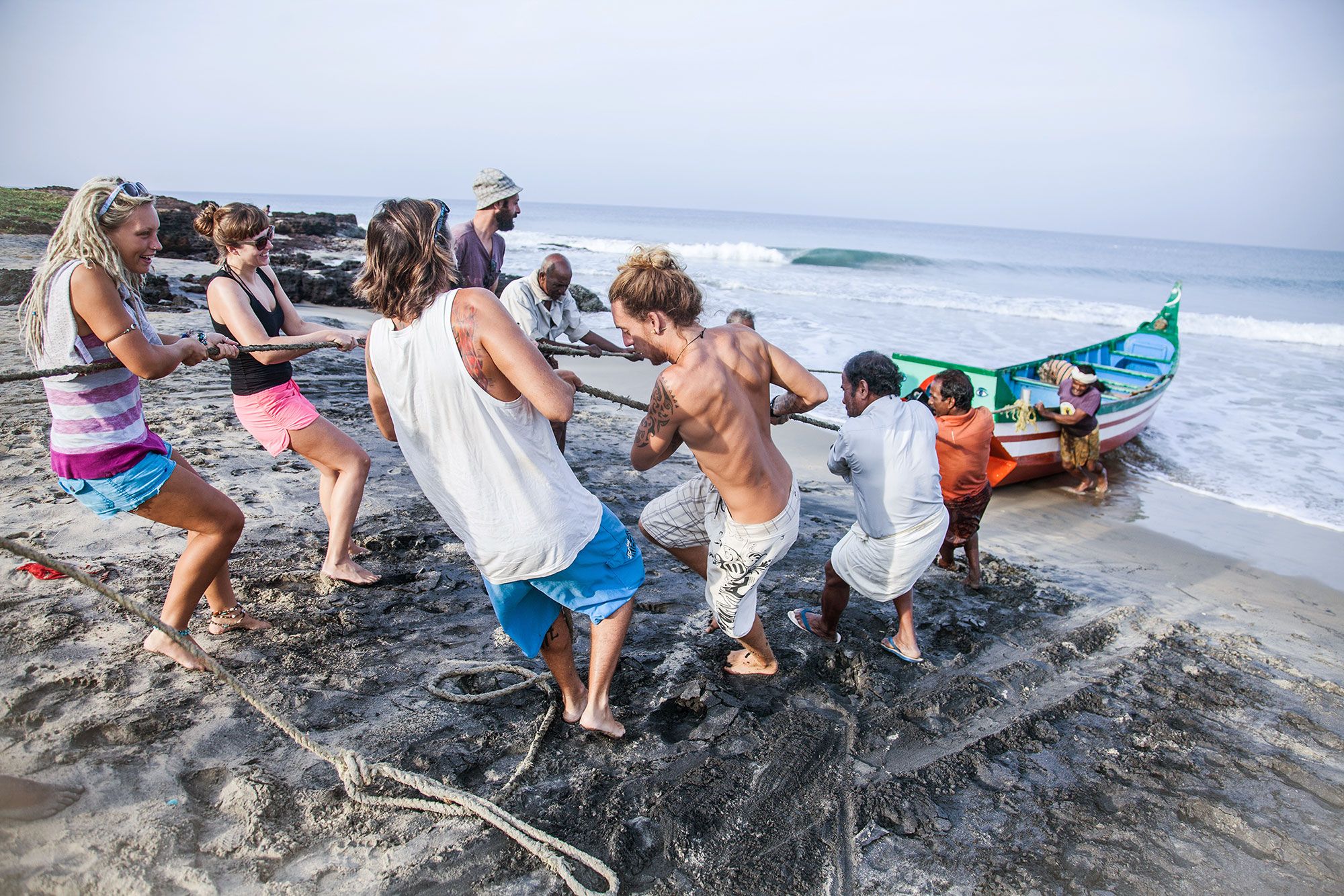Piolets d'Or Announces the "Significant Ascents" of 2023
This list of 68 climbs is effectively a "long list" used to select nominees of the prestigious alpine award.

Fishermen near Varkala, a fishing town in Kerala in south India, drag their boats to the shore, chanting loudly as birds circle above in hopes of scavenging some fresh fish. Dolphins play in the waves in the distance, but closer to shore a surfer riding a wave takes center stage. Positioning herself in a small barrel wave, she moves further out, cutting into the surf as fishermen look on, wondering what she is up to. India has never been known for surfing. However, today the country offers one of the most unique surfing spots in the world.
“The colour of the sea, the cliffs, the coconut trees and the bright boats are so incredible. They look unreal. It feels like I am surfing in an artist’s pallet that seems to always be changing and evolving,” says Lucy Perkins, a yoga instructor from the UK, who now spends her early mornings at a surf spot close to Varkala.
“How do you catch fish with this?” The fishermen ask the surfers as they study their surfboards. “What’s the point then, if you don’t fish with them?” They raise their eyebrows.
Locals have yet to get used to these foreigners with their strange boards, while the surfers themselves marvel at having great breaks at hand and few surfers to share them with. Franco Rebagliatti is an Argentinian currently working in Kerala as a masseur and trying to fit in as much surfing as he can. It’s already his second season in India. “Sometimes I explore new breaks and the local people get together on the beach to watch me surf," he said. "They take photos with cell phones, want to touch the board and ask thousands of questions. It’s fun, you feel like a super hero."
Raffael Kably, a manager at one of the resorts in Varkala, comes to the beach early morning before work. Originally from Mumbai, Raffael moved to Varkala to be able to surf whenever he can. “My family didn’t like the idea of me shifting to a surf town but now they are used to it," he says.
As an Indian, Raffael gets a lot of questions from the locals. “For them the beach is a livelihood, like an office,” he said. “They try their best to avoid waves, so when they see someone actively looking for waves they wonder what is wrong with these people.”

It is not only the surf that distinguishes a number of the beaches along the Keralan coast. Small fishing communities scattered along the coast who eke a living from the waves also have their own unique character. While surfers are out having fun among the waves, the fishermen are hard at work earning a living. Even then, a certain sense of camaraderie seems to exist between the two. The surfers help the fishermen drag their boats, while the fishermen not only watch the foreigners riding the waves and ask questions about it, some also ask to try it out for themselves.
“Let’s go, it’s time to go, come back! There is a lot of fish waiting for us!” One fishermen shouts from the shore to his friend who is having fun experimenting with the surfboard. “Come back!” The fisherman becomes impatient. His friend, however, is far from caring; he is rapt like a small child in his new discovery - surfing. The boat remains on the shore.
“We’ve been really lucky that the local fishermen are so cool with us surfing on their beach," Lucy said. "Sometimes a group of them sits on the sand and watches us surf when they finish work. They whoop and cheer when I or the other surfers get a long wave or make a big drop, so I guess they could see what we were aiming for. It's their way of encouraging us. I've always felt safe on that beach, especially when I was there alone. I felt they were keeping an eye on me to check that I was OK. Not all the fishermen can swim, but I know they’d be there for me if I needed any help."
Here one can experience not only the rich and diverse culture that India is famous for, but also witness the birth and progress of a new surfing destination and culture. There’s a real thrill in knowing that no else has done what you are doing in this place before. That’s why India is so special, because here that is still possible.
Both foreigners and local surfers seem to get along very well, and they teach, support and encourage each other. “I probably would never have met all those local guys if it hadn’t been for our love for surfing and it meant we instantly had something in common," Lucy said. "No matter how different our lives had been before, when we met we were all there for the same reason, and we had so much fun in the water together."

Raffael says that the Indian surfing community is still very small, and is happy to share the waves with foreigners and learn from them. "I got excited to see other surfers in the water, because I got to share my love for surfing with more experienced surfers and different people from all over the world." It’s not always easy for locals to start learning to surf. Expensive surfing equipment and a lack of quality instruction are hurdles in a small beach community to those who would wish to learn. That’s why a group of surf instructors from the “Soul & Surf” resort have started a Sunday surf club for local kids. Joshua Stenning from England is one of the organizers.
“We arranged to meet with local boys once a week and give them our full attention to help teach them," he said. "We began by teaching them how to swim, some basic ocean safety and then how to surf. These skills now allow them to enjoy the perfect waves on their own doorstep with some degree of style and skill too, and not to only look at them with fear."
It’s Sunday afternoon and Yousaf, Mohamed, Habeeb, Jerry, Nabill and Shahs have turned up for the surf club. They look impatient and excited. The boys know very little English, and the instructors know very little Malayalam, so the process of teaching and learning is always a little challenging.
“It has been a lot of trial and error, and completely different to the surf coaching that me and other instructors are used to," Joshua said. "We have to teach with our actions and expressions; and actually, this is the best way when it comes to surfing in any case. Sometimes it was them teaching us, too. Leave out the structure of a normal lesson; get stuck in, show by example and action and most of all, play!"
The best surfers are those that have the most fun on the waves. The boys are more than ample evidence of this. They are fearless and restless, and they are out there enjoying the surf like no one else; trying to catch every wave, dropping in and racing each other, first surfing then falling, only to paddle out again for the next wave. However, surfing is more than just technique.
“Surfing helps communities in many ways," Franco says. "When introducing surfing to new places, it’s good to carry a strong message. Surfing should be a way for local kids to learn how to interact with the ocean. It should discourage them from smoking and drinking and encourage them to choose a healthy lifestyle instead."
Joshua agrees that surfing gives local boys a chance to express themselves in the water and on the waves. “They can now start to use the beaches that their community is centered around as a place for fun and socializing, not just as place of work”, he adds.

Surfing in India is still far from common, and women surfers are even more of a rarity. But Lucy and a few other foreign girls have proved they can do it as well as the boys, and have provided an example for local girls.
“Usually girls are asked to sit at home while boys can go out and do what they want," Raffael said. "Also, surfing is quite extreme and physical, and this might be the reason why you only see boys out. I think this will all change slowly.”
“One of the problems is beach culture, which across the world is most popularly represented by bikinis and sunbathing,” he explains. “Indian parents are worried that if their girls go out onto the beach, they will become part of that culture, which is not really acceptable here.”
“We had to get used to being stared at a lot but I think it’s more out of curiosity than anything else," Lucy said. "One of my guy mates had a local Indian man come up and ask him if I was going to surf with them when I was standing right next to them. I think he wasn’t sure what to think of me, but soon accepted that I was joining the guys, even though he may not have understood why.”
With Indian female surfers/role models such as Ishita Malaviya and Suhasini Damian and the opening of new surf clubs, the situation will likely change over time. “We can only hope that these narrow minds broaden, and we begin to see a mixed sex surf community here,” Joshua said.
Though the community in Varkala seems to be taking kindly to the new trend on their beaches, environmental problems pose a serious challenge to surfers. Fishermen use the beach as their bathroom, and the waves wash a lot of garbage onto the shore. At the Sunday surf club lessons, Joshua and the other instructors hand out empty bags to the boys. All of them then spread out onto the beach and start to fill the bags. The surf club only begins when the group has filled at least two large bags each with the trash, garbage and recyclable waste that litters the beach.
“As surfers, we are using and taking from nature; so we need to look after it if we wish to continue,” Joshua says. “These are lessons that in the west we are brought up to understand. Here in India, these lessons are not taught. We are trying to show the boys that if they look after their environment even on a local, small scale then they will directly benefit from it.”
“This is a country where surfing is still relatively unknown, but one that has plenty of waves," Joshua said. "Surf tourism will soon rapidly grow, and if these local boys and hopefully girls can be the first to benefit from the influx of surf tourism then this can only be beneficial for them and their community."
"But equally, it shouldn’t disrupt the local businesses, like fishing, that have been there far longer than we surfers have,” Lucy adds. “The beaches belong to them after all, not us.”

There are already over eleven surf schools in India, and the surfing competitions that are held across the country a few times a year give fishermen-surfers the opportunity to display their skills.
“Surfing in India is a really a deep experience," Franco said. "And it’s very unpredictable - you will never be able to really understand how everything works, socially and surf-wise. So it will test you in many ways, but once you get through that and are ready to deal with unpredictability, the reward is truly beautiful."
Feature Image: Fishermen are dragging their boat to the shore after the morning fishing. Meanwhile, Lucas, a surfer and scientist from Argentina starts his surfing lesson on Edawa beach. In Kerala, surfers and fishermen have learnt to co-exist. PHOTO by Berta Tilmantaite
This story was part of the Features section of The Outdoor Journal Spring 2015 edition of the print magazine.
2nd best newsletter in the universe